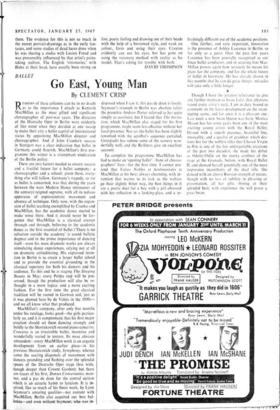Go East, Young Man
BALLET
By CLEMENT CRISP
READERS of these columns can be in no doubt as to the importance I attach to Kenneth MacMillan as the most gifted and significant choreographer of post-war years. The directors of the Deutsche Oper in Berlin were evidently
of like mind when they decided at one swoop to make their city a ballet capital of international status by appointing MacMillan director and choreographer. And if John Cranko's success in Stuttgart was a clear indication that ballet in Germany could flourish, MacMillan's first pro- gramme this winter is a triumphant vindication of the Berlin policy.
There are two factors needed to ensure success and a fruitful future for a ballet company: a choreographer and a school; given these, every- thing else will follow. Germany's tragedy, so far as ballet is concerned, was that during the years between the wars Modern Dance (misnomer of the century) reigned supreme, with all its tedious apparatus of expressionistic movement and absence of technique. Only now, with the expan- sion of ballet teaching exemplified by Cranko and MacMillan, has the academic dance started to make sense there. And it should never be for- gotten that MacMillan is a classical creator through and through, believing in the academic dance as the first essential of ballet (`There is no salvation outside the academy' is sound balletic dogma) and in the prime importance of dancing itself—even his most dramatic works are always stimulating dance experiences, relying not at all on dramatic attitudinising. His expressed inten- tion in Berlin is to create a larger ballet school and to provide the essential grounding in the classical repertory for both his dancers and his audience. To this end he is staging The Sleeping Beauty in May; every Petipa step will be pre- served, though the production will also be re- thought in a more logicai and a more exciting fashion. For the first time the great classical tradition will be rooted in German soil, just as it was planted here by de Valois in the 1930s— and we all know what that produced.
MacMillan's company, after only five months under his tutelage, looks good—the girls particu- larly so, and it is symptomatic that his first major creation should set them dancing strongly and boldly to the Shostakovich second piano concerto.
Concerto is an irresistible ballet, inventive and wonderfully varied in texture. Its most obvious antecedent—every MacMillan work is an organic development from an earlier piece—is his previous Shostakovich study, Symphony, whence come the soaring diagonals of movement with
dancers pounding and flashing over the splendid spaces of the Deutsche Oper stage (less wide, though deeper than Covent Garden); but there are traces of his first, Danses Concertantes, man- ner, and a pas de deux for the central section which is an ecstatic hymn to lyricism. It is in- spired, like so much of his finest work, by Lynn Seymour's amazing qualities—not content with MacMillan, Berlin also acquired our best bal- lerina—and even without Sepuoutc.whe.wais, in.
disposed when I saw it, this pas de deux is lovely. Seymour's triumph in Berlin was absolute (after the premiere Andrew Porter referred to her quite simply as assoluta), but I feared that The Invita- tion, which MacMillan also staged for his first programme, might seem less effective without her focal presence. Not so; the ballet has been slightly reworked with the acrobat's sequence curtailed, Georgiadis has redone some of the scenery won- derfully well, and the Berliners give an excellent account.
To complete the programme MacMillan has had to make an 'opening ballet'—bane of choreo- graphers' lives—for the first time. I cannot pre- tend that Valses Nobles et Sentimentales is MacMillan at his best; always charming, with in- vention that warms to its task as the waltzes go their slightly bitter way, the best things in it *are a poetic duet for a boy with a girl obsessed with her reflection in a looking-glass, and a re- freshingly different use of the academic positions.
One further, and very important, innovation is the presence of Ashley Laurence in Berlin, so far only as a guest. Over the past few years Laurence has been generally recognised as our finest ballet conductor, and in securing him Mac- Millan proves again how seriously he means his plans for the company, and for the whole future of ballet in Germany. He has already shown in live months that he can do great things: miracles will take only a little longer.
Though I have the greatest reluctance to give any further mention to Swan Late, that albatross round every critic's neck, I am in duty bound to comment on the latest development on the swan- upping scene, and for once it is a pleasant one. Last week a new Swan Queen was born. Monica Mason has for some years been one of the most exciting young artists with the Royal Ballet; blessed with a superb presence, beautiful line, musicality, and a quality of grandeur which des- tines her for the noblest roles (her Chosen Virgin in Rite is one of the few unforgettable creations of the past two decades), she made her debut as Odette/Odile on the murky confines of the stage at the Granada. Sutton, with Royal Ballet 11, and showed herself potentially one of the most impressive incumbents of the dual role. She danced with an almost Russian strength of means, though with no loss of subtlety in phrasing or presentation, all her gifts shining at their splendid best; with experience she will prove a great Swan.


































 Previous page
Previous page